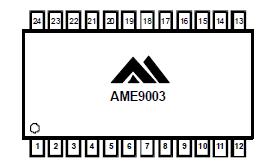AME9003: Features: · Small 24 pin QSOP package· 24 pin PDIP/SOIC also available· Drives multiple tubes· Special 1 second start up mode· Automatically checks for common fault conditions· 7.0V < Vbatt < ...
floor Price/Ceiling Price
- Part Number:
- AME9003
- Supply Ability:
- 5000
Price Break
- Qty
- 1~5000
- Unit Price
- Negotiable
- Processing time
- 15 Days
SeekIC Buyer Protection PLUS - newly updated for 2013!
- Escrow Protection.
- Guaranteed refunds.
- Secure payments.
- Learn more >>
Month Sales
268 Transactions
Payment Methods
All payment methods are secure and covered by SeekIC Buyer Protection PLUS.

 AME9003 Data Sheet
AME9003 Data Sheet







